Can’t keep up with the rising pace of order fulfillment all alone?
Running off your feet to print shipping labels at the post office?
Leaving yet another customer unsatisfied because you lost the order tracking number?
No worries, we’ve got you covered. Or rather, ecommerce shipping software integration has got you covered. In 10+ years of experience, we at Elogic have seen our clients influencing buyers, increasing sales, delivering a pleasant post-purchase experience — all thanks to the Magento shipping integration.
So let us share our expertise and walk you through the process of shipping software selection. What you should be looking for in a shipping solution; is Magento shipping enough for your needs; what best ecommerce shipping solutions we recommend to Elogic clients — see the answers to these questions in this full-fledged guide.
Ecommerce Shipping Software 101: The Basics You Need to Know
Ecommerce shipping is transporting the goods from a retailer to a customer’s destination. It forms a part of the order fulfillment process, which implies order processing after a customer hits the “Add to Cart” button. Both operations can be handled by merchants themselves in-house or outsourced to third-party carriers.
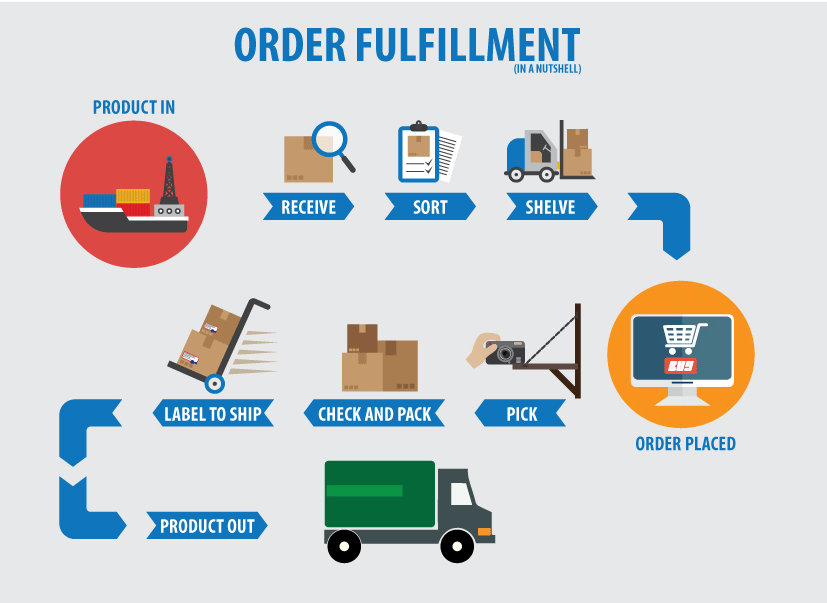
The primary function of shipping software is to automate the order fulfillment process and manage the logistics for the merchant. Any shipping platform for ecommerce shall eliminate all the manual work for the merchant’s ecommerce team and organize the workflow for processing orders. Advanced solutions also calculate real-time shipping rates and generate shipping labels that a merchant can immediately print and attach to the packages.
The shipping process starts after the customer checks out and involves the following tasks:
- — Inventory preparation
- — Order packaging
- — Invoice creation
- — Order dispatch
- — Package transfer to the shipping courier
Ecommerce shipping software is easy to integrate with most ecommerce platforms. Because Magento holds such a big share of the market, practically any shipping solution will have the option of integrating with Magento.
Benefits of Using Ecommerce Shipping Software [Based on Real Business Cases]
Software features sound good on paper, but how will they benefit an actual business? Here are some shipping software benefits we’ve gathered from real-life case studies in ecommerce.
Take Full Control of the Shipping Process
Because the whole shipping process becomes automated, you will stay up-to-date on your levels of inventory, order tracking numbers, as well as business partners and customers. You’ll eliminate the risk of a human error and, thus, increase the efficiency of the ecommerce team, just like Glovo did.
FTP automation became a winning feature for us in our business. We can now easily import and export inventory files, confirm orders, update the status of our inventories in the warehouses, export shipments all within minutes, thereby increasing our efficiency
says Maria Vicentin, COO of Glovo.
Integrate Orders From All Sales Channels
The best shipping software for ecommerce will retrieve orders automatically from anywhere you sell and update tracking numbers and order status for your customer. This accurate, real-time data flow is of particular benefit to multichannel retailers, like Appalachian Organics.
The ability to connect multiple marketplaces is a great benefit for a multi-channel seller like us. Our inventory is more accurate because we’ve eliminated duplicate ordering. Since shipping is integrated, we log in once and can manage multiple things, which saves us a ton of time.
says Shaun Donovan, CEO and founder of Appalachian Organics.
Save Time & Money
Most popular shipping solutions connect to multiple carriers and offer discounted shipping rates. As such, a merchant can evenly distribute the inventory closer to the customer, thus, speeding up the delivery and reducing the shipping fees for the clients.
A California-based organic food brand Ample Foods is a perfect case in point:
We are excited to be able to offer 65% of our clients with a 2-day shipping, up from 32% by only having a single West Coast facility. Soon, this will be 100%. Not only is this better for our customers but we also gain a 13% savings to our bottom line.
says Pablo Gabatto, Business Operations Manager at Ample Foods.
Manage Returns
Save yourself from exhausting trips to the post office — generate return labels at your warehouse! With the right shipping solution, you can print labels one-by-one or create manifests for shipping packages in bulk.
Chubbies, a brand of casual apparel, now only needs an order number and one’s shipping address zip code to print and add a label, which cuts unnecessary costs and saves time on return shipping:
We use their [shipping system’s] webhooks and API in our app to reduce our returns timeline by over 50% and let customers know when their new gear is shipping back out. This effortless return experience is key to maintaining customer loyalty and repeat customer purchases.
says James Hargett, Fulfillment Manager at Chubbies.
Sell Internationally
Shipping is the biggest headache when selling overseas. Yet, quite a few delivery solutions have their fulfillment centers around the globe and offer pre-filled custom forms to handle cross-border logistics. Take an American tattoo supplies store Black Claw, for example:
ShipBob [one of the best shipping software for ecommerce] has multiple fulfillment centers in the US, one in Canada, one in the EU, and one in the UK. All locations filter back into one centralized warehouse management system. By distributing our inventory across these countries and regions, all of our customers are able to get their orders much faster while paying reasonable domestic shipping rates.
says Wes Brown, Head of Operations at Black Claw
Things to Look Into While Choosing the Best Shipping Software
As a merchant, you have to realize that there’s no one-size-fits-all shipping solution. You should choose a shipping system based on your business needs and requirements.
Here are some of the functionalities you might be looking for in an ecommerce shipping solution:
- Different shipping options
There are three main types of shipping options: flat rate, table rate, and real-time rate. Flat-rate shipping implies charging the same fee no matter the weight and size of the order. Table rate follows a set of rules for shipping you personally create based on product sizes, destinations, or order totals (a useful option when shipping internationally or selling B2B). Real-time shipping rates are calculated automatically and synchronized in real time with your carrier (FedEx, UPS, USPS, etc.). - In-store pickup
An in-store pickup option is useful for those who run both an online and a brick-and-mortar store. Not all software supports this feature so it may be a deciding factor when choosing a shipping solution to invest in. - A variety of shipping methods
In addition to various shipping rates, your solution might connect to different carriers. You’ve probably seen this on sites like eBay and Amazon which offer different shipping speeds, carriers, and priorities. - Reduced shipping costs
All of the shipping solutions we’ll discuss in this article partner with large shipping carriers like UPS and FedEx to offer reduced shipping rates. For example, one of the shipping solutions we will look at, Ordoro, offers a 67% discount for USPS shipping. - Label, slip, and list printing
Instead of having to run to the post office, most shipping software allows you to purchase labels without leaving your office (some even offer mobile apps). You can then print the labels or slips out and save yourself loads of time. - 3PL / warehousing
Some shipping solutions act as third-party logistics companies (3PL) and will offer you their warehouses to store your products. A merchant will be able to expand beyond shipping from their house or garage and save on owning their own warehouse and hiring warehouse staff. - Reporting tools
The software we’ll be looking at includes reporting and analytics tools. You can view stats like where you ship to most frequently, how much you ship, and which products are shipped. You can use this information to launch targeted marketing campaigns or adjust your shipping strategy. - Automation
The biggest thing our clients look for are automation tools. By automating shipping processes, staff spends less time on tedious manual tasks and a merchant can focus on growing their business (see more benefits in the previous section).
Obviously, not every shipping solution will have all the aforementioned features (otherwise, we’d find a perfect one for ecommerce!). Yet, you can still find your best shipping software for ecommerce based on which feature you need most for your business.
Wait, but what if you’re a Magento store owner? Maybe you don’t even need to spend extra! Before we list our top shipping software winners, let’s take a look at the Magento Shipping option for ecommerce.
Are Magento Shipping Features Enough for Ecommerce Merchants?
Magento 2 provides a fairly robust set of shipping tools off-the-shelf. A merchant can configure shipping methods and adjust shipping rates right off the Admin panel.
Take note: As of September 24th, 2019, Magento Shipping has ceased to exist as a separate built-in module. Instead, the company has integrated shipping functionality in both Magento 2 Commerce and Open Source.
Here are the features a Magento merchant can benefit from without integrating any third-party software.
Free Shipping
Let’s say you want to offer free shipping for all orders above $50. You can set up this rule by going to Stores → Configuration → Sale → Shipping Methods → Free Shipping menu. Fill in the Title box (the name of the payment method your customers will see), minimum order amount (e.g., $50), and the countries eligible for free shipping.

Carrier Configuration
Out of the box, Magento connects to United Parcel Service (UPS), United States Postal Service (USPS), FedEx, and DHL. Before configuration, you’ll have to open your shipping account with them to enter your account number or assigned ID in the Magento system. You can also set the ways to send an order (by air, ground, courier, dropshipping, etc.).
Flat Rate
Flat rate in Magento 2 means a fixed shipping fee for any order, no matter its size or weight. It might be a useful solution for merchants with low-volume stores or for those who haven’t engaged with any delivery service yet. To configure the flat rate method, go to Stores → Configuration → Sale → Shipping method → Flat rate.

Table Rate
So you’ve decided to ship to the state of New York at a reduced rate. Or give a shipping discount for all customers who order three items from your store. These rules can apply in a table rate that you can configure in the following steps:
Step #1: Go to Stores → Configuration → Sale → Shipping method → Table rate and configure the Table rate settings.
Step #2: Select Store view in the upper left corner of the panel and export CSV file. Fill in the CSV table with the values of your shipping table rates.

Step #3: Import the table rate data into the shipping method configuration.
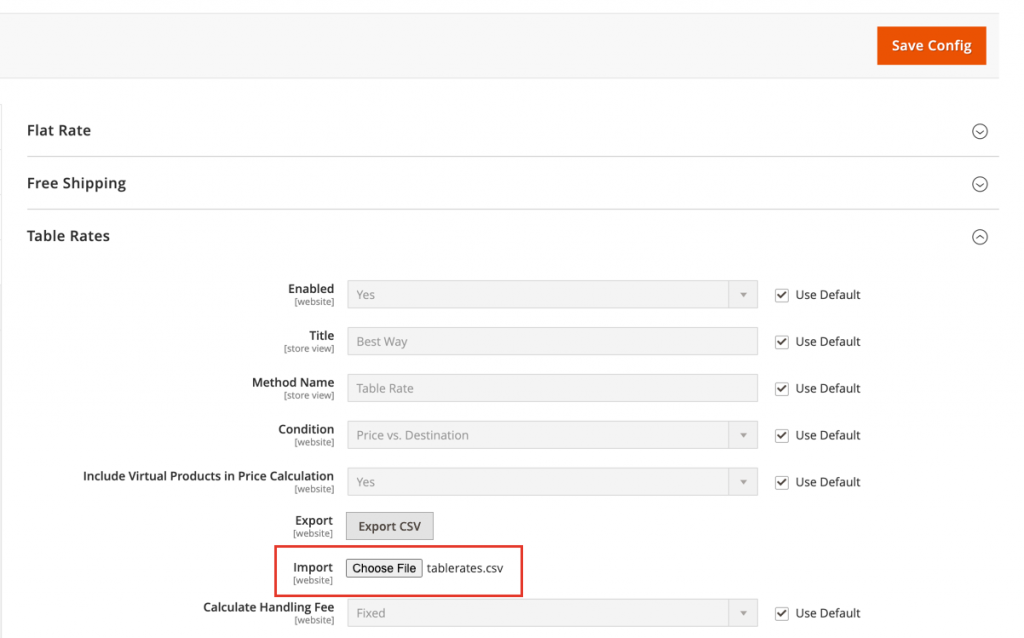
In-Store Delivery
Click-and-collect sales have boomed in 2020: of the nearly $200 billion in new ecommerce spending in the US, $37.44 billion came from in-store pickups. Magento will keep you prepared for the new trends with an in-store delivery feature. Go to Stores → Configuration → Sale → Delivery methods and expand the In-Store Delivery menu. You can specify the fee to be charged for the service and your storefront in case you have multiple sales points.

6 Best Shipping Solutions for Ecommerce
If the built-in Magento shipping features are not enough, your only option is to integrate a third-party solution.
The market is competitive, and the choice of software may be tough. So we’ve decided to ease your life a bit and make a list of top shipping software.
What are our selection criteria? The aforementioned functionalities and our own experience. These six shipping integrations are requested by our Magento clients most often. For your own convenience, they will be categorized by one’s business needs. Let’s dive right into the list!
ShipperHQ for Accurate In-Cart Rates
Business need: “I have very specific (often complex) requirements about shipping my products, so I want to introduce various shipping options and rates at the customer checkout.”

You know how Magento is the king of customization? Well, ShipperHQ is the same but in the shipping software niche. Providing one of the best shipping for ecommerce, ShoppierHQ has been developed by WebShopApps, a leading Magento shipping extension development agency.
ShipperHQ provides innovative cart customization and enterprise-level functionality. You might want to offer free shipping only for a certain number of products. Or limit an item’s shipping to a particular location, as in the case of selling wine online. Or apply different rates to various customer groups the way B2B businesses do. In all these cases, ShipperHQ has got you covered. Although the solution doesn’t print or issue labels, it’s easily integrated with other apps and multiple storefronts.
ShipperHQ main features:
- Multiple carrier support: 30+ partners, including less-than-truckload freight carriers.
- Dimensional packing and real-time shipping rates: get the most accurate rate for your shipment.
- Multi-origin shipping: offer options like in-store pickup, LTL freight shipping, and same-day delivery at checkout.
- Delivery date and time: allow customers to choose their preferred delivery date from a calendar at the checkout.
- Analytics: view reports on your customers’ destinations, average weight of your shipments, types of rates, etc.
- Additional features: dropshipping, in-store pickup, address validation, among other customization tools.
ShipperHQ pricing: depends on your ecommerce platform and is paid on a subscription basis. The cheapest plan for Magento merchants starts at $100/month and grows as the features add up.
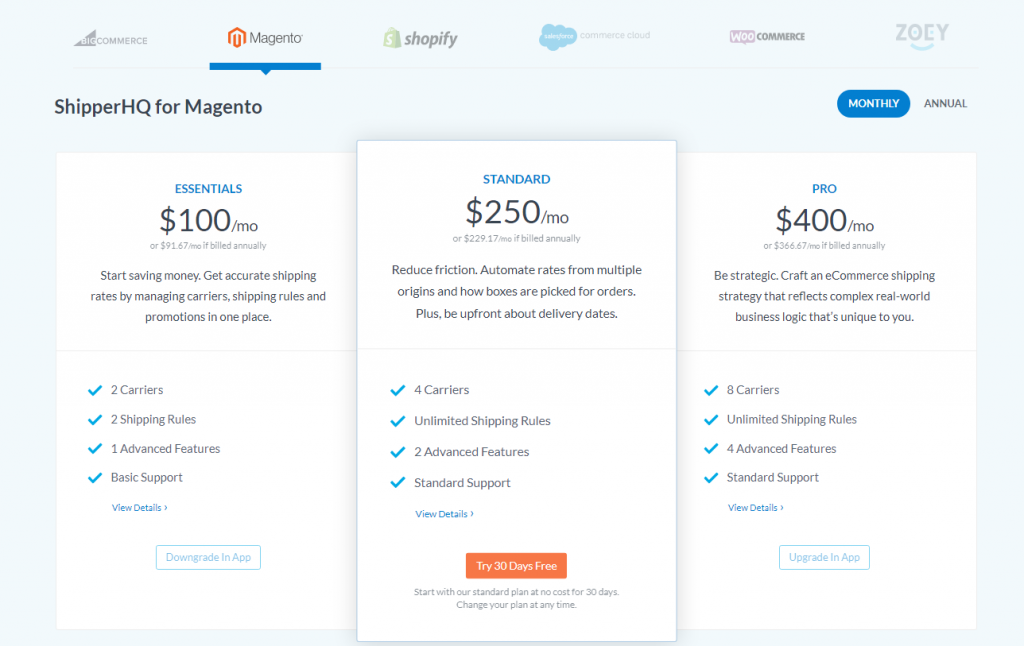
ShippingEasy for Easy-To-Use Dashboards and Automated Fulfillment Process
Business need: “I’m a small business owner running a store alone and looking to automate my order fulfillment process. Ease-of-use and discounted shipping rates are important for me.”

One thing you need to know about ShippingEasy is that it lives up to the expectations: it is indeed easy to use.
ShippingEasy is one of those universal solutions for small to mid-sized businesses who ship out too many orders to handle alone but not enough to rent a warehouse or a 3PL. The cloud-based SaaS shipping system provides one of the lowest commercial rates for carriers like UPS and USPS. Clients also praise it to be the best shipping solution for ecommerce for excellent customer service and seamless integration with major ecommerce platforms and marketplaces.
ShippingEasy main features:
- Multiple carrier support: USPS, FedEx, UPS, DHL, and DHL Express.
- Workflow automation: create automation rules for managing orders and printing labels, delivery preference, and package size.
- Discounted rates: USPS discounts for Priority Mail, Flat Rate, Regional Rate, Express Mail, and International up to 62%.
- Alexa for shipping: use Alexa to get order information, batch print labels, pick lists, and much more.
- Tracking and returns: send real-time tracking info to your customers and use pre-paid and scan-based return labels.
- Additional features: customizable email templates, automated emails and notifications, marketing tools, custom product kits, barcode scanning, order management, inventory management, supplier management, analytics, and shipping insurance.
ShippingEasy pricing: free for <50 shipments per month. Other subscription plans vary from $5 to $150/month depending on the advanced features and the number of shipments. More info on ShippingEasy pricing can be found on the official website.

ShipStation for Multi-Channel Label Printing and Dropshipping
Business need: “I sell on the website, social media, and marketplaces. I wish I could manage shipments for all these channels from a single place to print labels and avoid duplicate orders.”

ShipStation wins the market competition for its order integration from anywhere you sell. It’s never been so easy to synchronize order fulfillment strategies for Amazon, eBay, Walmart, Etsy, and social networks on top of other marketplaces. The software provider also has a mobile app for Android and iOS, which a merchant can use to print labels and add branding info to shipments.
ShipStation main features:
- Multiple shipping methods: USPS, UPS, FedEx, DHL International, Canada Post, or Amazon Seller Fulfilled Prime accounts, and 30+ more carriers.
- Smooth integration with 70+ platforms and sales channels.
- Real-time shipping rates: listed both in cart and at the one-step checkout.
- Automation rules: customize the shipping process and create branded labels and packing slips.
- Discounted rates: USPS discounted rates via freestamps.com and includes a free Express 1 account with discounts on USPS Priority and Express Mail.
- Additional features and tools: branded emails and notifications, branded tracking pages, package return management, and analytics.
ShipStation pricing: 6 pricing plans from $9/month to $159/month depending on the number of shipments, users, and features. Merchants with >10.000 shipments should contact the provides for a custom quote.
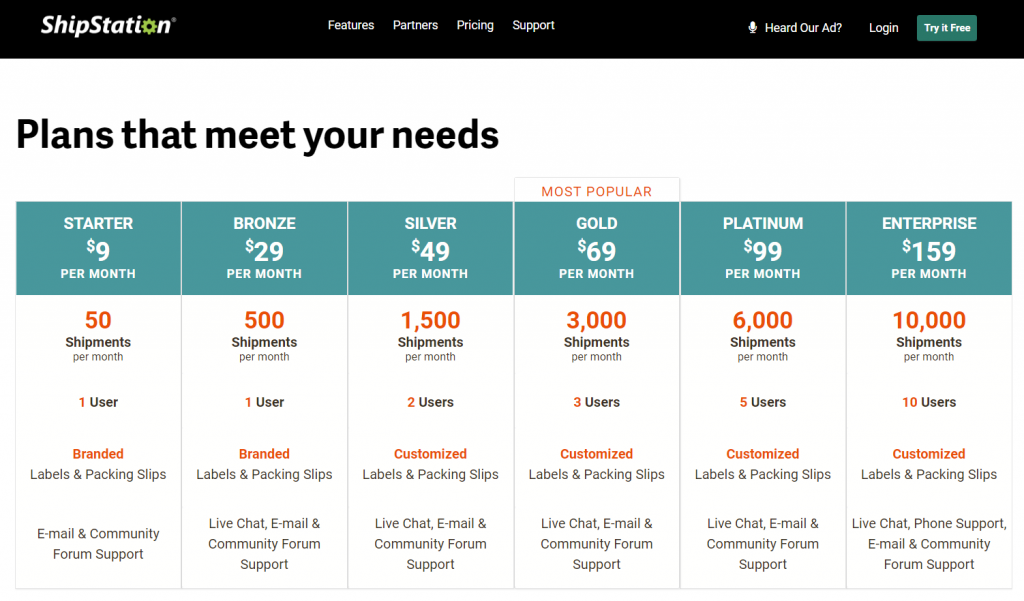
Shippo for Smooth International Shipping
Business need: “I am planning to expand my business and look for a shipping partner to ship my products overseas.”

At the level of ease of use and intuitiveness, Shippo is a direct competitor to ShippingEasy. But a real strength of Shippo is that it collaborates with some best ecommerce delivery carriers outside the US. The software provider handles customs, duties, and freight and ensures your customers in Europe or Canada receive their parcels fast. Customers also get automated branded emails with the tracking code to check where the order is and which carrier shall deliver it to the final destination.
Shippo main features:
- Multi-carrier support: 55+ carriers including regional, national, and international. Also offers next-day delivery for selected carriers.
- Discounted shipping rates: up to 90% discounts for USPS, up to 75% for DHL Express, and others discounts for international carriers like Fastway Australia and Sendle.
- Automation: automatically create labels in batch and send customers tracking information.
- Additional features and tools: branded emails and notifications, customs forms creation, shipping insurance, package return management, order splitting, and analytics.
Shippo pricing: free for <200 shipments per month and $10/month for high-volume shippers.

Ordoro for Efficient Dropshipping
Business need: “I sell to a number of customers across the country but want to save on warehouse maintenance and order fulfillment.”

Dropshipping is all about a merchant using a partner to stock the products and fulfill the orders. In addition to its shipping features, Ordoro is renowned for its advanced inventory capabilities and, therefore, efficient dropshipping.
Specifically, merchants can synchronize their inventory across all ecommerce channels and set up vendor portals to let suppliers access and fulfill orders. The inventory and dropshipping features are available in the Pro and Enterprise plans of the SaaS shipping solution, though.
Ordoro main features:
- Multiple shipping options: USPS, UPS, FedEx, DHL International, Canada Post, or Amazon Seller Fulfilled Prime accounts.
- Real-time and discounted shipping rates: up to 67% through USPS.
- Automation: auto-fill shipping parameters when creating labels and automation rules for order management.
- Inventory management and dropshipping: route each product to the assigned dropshipper.
- Additional features: custom product kits, barcode scanning, supplier management, analytics, order-splitting, and shipping insurance.
Ordoro pricing: Express plan starts at $59/month and includes all the basic features. Inventory management and dropshipping capabilities are available only in the Pro and Enterprise plans, which cost $499/month and $999/month correspondingly.

ShipBob for Advanced Fulfillment and Warehousing
Business need: “I’m an established brand owner serving the customers nationally and internationally. I am looking for a solution that will ship my products blazing fast and take charge of the complex order fulfillment process.”

ShipBob should be an instant choice of mid-sized businesses and large enterprises. It is one of the best ecommerce shipping solutions and an efficient third-party logistics (3PL) partner for high-volume online stores.
ShipBob has multiple warehouses across the US, in Canada, and in Europe. For this reason, merchants can benefit from its next-day and 2-day delivery options. The shipping software provider will also pick, pack, and ship your item, as well as provide the tracking number for your customer. You’ll be notified about the whole order fulfillment process and restock the inventory on time, whenever needed.
ShipBob main features:
- Multiple carriers: major shipping services, like DHL, UPS, FedEx, and USPS, among others.
- Real-time and discounted shipping rates: available for FedEx, UPS and USPS, as well as freight carriers.
- Automated order management: check the order status, view shipping-related info, and make changes if necessary.
- Inventory management: see your stock levels in a particular fulfillment center and replenish it in the location with the highest demand for your products.
- Additional tools: advanced reporting, returns management, customer support, wholesale order support.
ShipBob pricing: flat rates apply for the services. ShipBob charges $25 for the first two hours of receiving your products, during which staff verifies your inventory counts and conditions. The provider also charges a $40 per month/pallet or $10 per shelf/month of storage fee for keeping your goods in their warehouses.
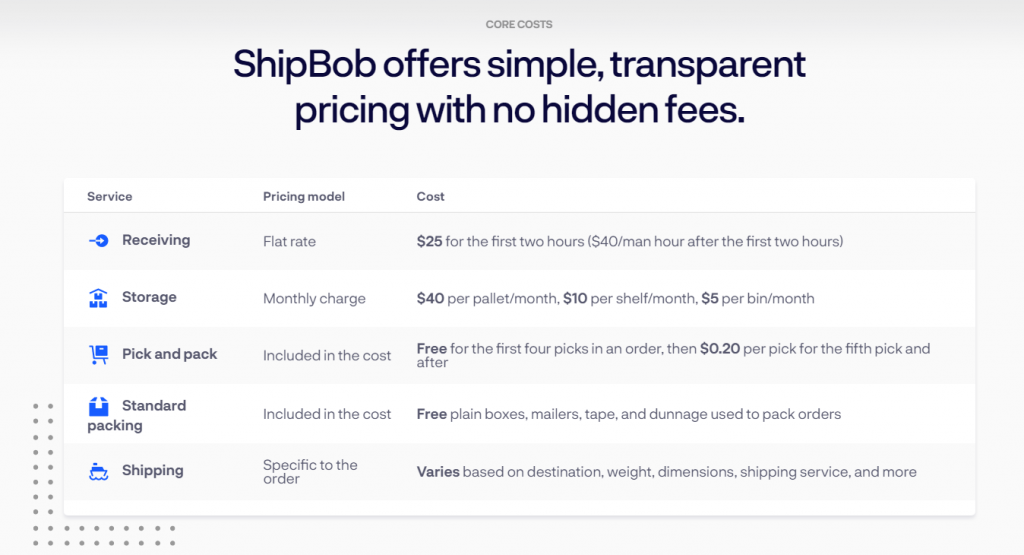
How to Calculate Shipping Costs For Online Businesses
Calculating the cost of shipping is a double-edged sword: you have to take care of your budget but also consider your customers’ wants and needs. About 66% of shoppers expect to see free shipping on the best ecommerce delivery, but only mature businesses can afford it without going broke.
To provide the best shipping for ecommerce and build trust with your customers, first, you have to go through shipping rates thoroughly. Most of them will depend on your shipping provider. Here’s what you have to take into account while calculating the ecommerce shipping costs:
- Shipping destination: the farther your package travels, the more you’ll have to pay. On international deliveries, you can expect to pay from $40 with USPS to $240 with FedEx.
- Package weight: lighter boxes will travel faster and cheaper. Mind that you should weigh the total package, not just the product itself. For instance, if you sell furniture online, you’ll need to consider all the additional packaging, like pallets, bubble wrap, and shredded paper.
- Package dimensions: this factor goes hand-in-hand with the package weight. You should calculate length x width x height of an item and keep in mind that shipping smaller packages will save you a pretty penny.
- Delivery time: next-day delivery will cost you more than three-day shipping, for instance. The rates vary depending on the shipping provider.
Once you’re done calculating the average cost of shipping an item, you can proceed to offer the best delivery model for your customers:
- Calculated shipping: you sum up all the aforementioned costs for shipping each item individually. It’s not the best model for those retailers who have 1,000+ different items in stock but will work for small ecommerce store owners.
- Flat-rate shipping: you calculate the average shipping cost for all your brand products and charge a stable rate for each item, no matter its weight or dimensions.
- Matrix rate shipping: you calculate it following the formula shipping cost x weight x cart value x destination. This model is popular among stores selling bulky or big-ticket items, like furniture or musical instruments.
- Real-time shipping: you integrate a third-party service that automatically calculates your shipping costs in real-time.
Here’s an example of how to calculate shipping costs if you run an online clothing store. You decide to go with USPS since most of your customers’ orders are placed in the US. Shipping a shirt with USPS First-Class Mail will cost you no more than $0.58 at the Post Office (13 oz rule applies). Parcels of up to 70 lbs will require Priority Mail Flat Rate and will cost $7.95 with fast 1-3 day delivery.
You get volume discounts based on the number of items you ship per year. Some best shipping software for ecommerce, like Shipping Easy or Shippo, also provides subscriptions to commercial pricing. Having integrated a third-party solution might save up to 40 percent on shipping.
Ecommerce Shipping Software Is an Integral Part of Your Business
Shipping is way easier once you automate the manual processes and synchronize your order data. It saves time and money (even if the pricing policies of our six best shipping solutions for ecommerce convince you of the opposite).
Investing in a shipping extension means you’re not only delivering products, you’re delivering a positive customer experience. Quick shipping is a sign of good business practice — keep that in mind and your customers will thank you.
Any of the best ecommerce shipping solutions may be yours — just wish for it!
Boost your order fulfillment process now
Integrate shipping software now
